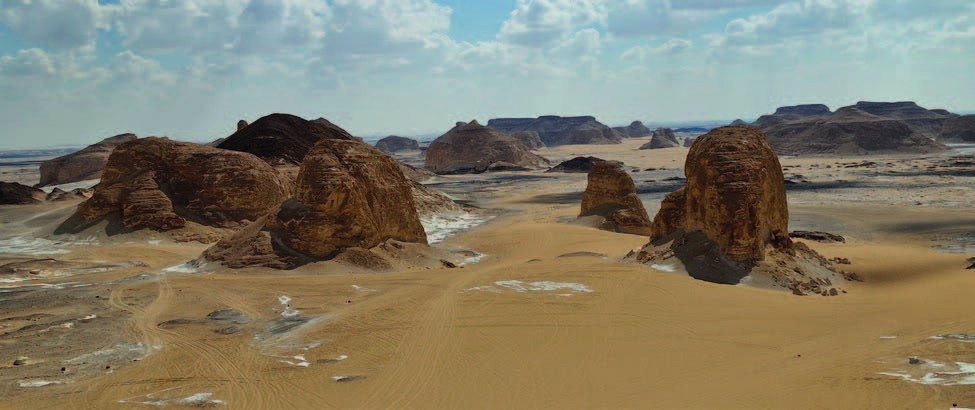Karst Rock Relief of Qara and White Desert (Western Desert of Egypt)
DOI:
https://doi.org/10.3986/ac.v52i2-3.12796Keywords:
carbonate rock, rock relief, complexometry, QaraOasis, White Desert (Farafra), EgyptAbstract
The karst rock relief clearly reveals the ways in which the karst surface and caves have been shaped and how they have developed. The oldest traces are the rock features of old karst caves, which were formed under climate conditions entirely different from the current ones, i.e., in the Pleistocene, and which have been dry for a longer period of time. Today, the wind is the prevailing factor in shaping the rock on the surface and in the karst of the White Desert near Farafra in particular, where we can witness the development of an entire range of wind rock features which helps us sort and classify them logically. However, in the wadis near the Qara Oasis a unique rock relief is forming, in which traces of water flow and dissolution of the rock under the sandy deposits are utterly predominant. The rainfall volume is low, however, the heavy rainfall events lasting short periods of time are enough to shape the less resistant rock. The rock features dominating the walls are co-shaped by dissolution and aeolian erosion. Crust forms on those parts of the rock surface that come in contact with water. The bare surfaces, on the other hand, are carved out by the wind. In the places where the crust has flaked off, the wind carves out cups.
Downloads
References
Al Farraj Al Ketbi, A., Slabe, T., Knez, M., Gabrovšek, F., Mulec, J., Petrič, M., Zupan
Hajna, N., 2014. Karst in Ras Al-Khaimah, northern United Arab Emirates. Acta carsologica, 43(1): 23-41.
Audra, P., Bosák, P., Gázquez, F., Cailhol, D., Skála, R., Lisá, L., Jonášová, Š., Frumkin, A.,
Knez, M., Slabe, T., Zupan Hajna, N., Al Farraj Al Ketbi, A., 2017. Bat urea-derived minerals in arid environment: first identification of allantoin, C4H6N4O3, in Kahf Kharrat Najem Cave, United Arab Emirates. International journal of speleology, 46(1): 81-92.
Catuneanu, O., Khalifa, M.A., Wanas, H.A., 2006. Sequence stratigraphy of the Lower
Cenomanian Baharia Formation, Baharia Oasis, Western Desert, Egypt. Sedimentary Geology, 190: 121-137.
Coy H. Squires, C., 1986. Geological map of Egypt, NH 35 SW Siwa, 1:500.000. The
Egyptian General Petroleum Corporation, Cairo.
Coy H. Squires, C., 1987. Geological map of Egypt, Ng 35 NE Farafra, 1:500.000. The
Egyptian General Petroleum Corporation, Cairo.
El Aref, M.M., Hammed, M., Salama, A., 2017. Geomorphological Classification and
Zonation of the Surface Karst Landforms of Bahariya-Farafra Region Western Desert, Egypt. International Journal of Science and Research V 6, I 5: 956-965.
El Awady, M.A.M., Abd-Elwahed, A.G., Garamoon, H.K., El Malky, M.G., 2018.
Geochemical Assessment of the Quaternary Soil in Siwa Oasis, Western Desert, Egypt. Journal of Environmental Sciences, 43(2): 25-45.
El Marsafawy, S., Bakr, N., Elbana, T., El Ramady, H., 2019. Climate. https://www.
researchgate.net/publication/327141448.DOI: 10.1007/978-3-319-95516-2_5
El Sisi, Z., Hassouba, M., Oldani, M.J., Dolson, J.C., 2002. Ancient Oil, New Energy.
International Conference and Exhibition, Field Trip No. 8. British Petrol, Shell, Cairo, 66 p.
Engelhardt, W., Füchtbauer, H., Müller, G.,1964. Sediment-Petrologie, Methoden der
Sediment-Untersuchung, Teil 1.- E. Schweizerbart´sche Verlagsbuchhandlung
(Nägele u. Obermiller), pp. 303, Stuttgart. http://onlinelibrary.wiley.com/
doi/10.1002/iroh.19650500317/abstract
Evamy, B.D., Sherman, D.J., 1962. The application of chemical staining techniques to the
study of diagenesis of limestones. Proc. Geol. Soc. London, 1599, 102-103.
Farouk, S., City, N., Abdel Ghany Khalifa, M., El Kom, S., 2010. Facies tracts and sequence
development of the Middle Eocene – Middle Miocene successions of the southwestern Qattara Depression, northern Western Desert, Egypt Freiberger Forschungshefte, C 536(18): 195-215.
Gindy, A.R., El Askary, M.A., 1969. Stratigraphy, structure, and origin of the Siwa Depression, Western Desert of Egypt. AAPG Bull, 53: 603-625.
Google Maps, 2023. Map.- [Online] Available from: https://www.google.com/maps/place/
Cara,+%D9%82%D8%B3%D9%85+%D8%B3%D9%8A%D8%AF%D9%89+%D8%A8%D8%B1%D8%A7%D9%86%D9%89%D8%8C+Matrouh+Governorate,+Egipt%E2%80%AD/@29.5975752,26.4774076,11087m/data=!3m1!1e3!4m6!3m5!1s0x14645414fff33539:0xd1966d35fa59d060!8m2!3d29.6057611!4d26.5019976!16s%2Fm%2F0gttcbl?entry=ttu [Accessed June 15th, 2023].
Hermina, M., 1990. The surroundings of Kharga, Dakhla and Farafra oases. In: Said, R.
(Ed.), The Geology of Egypt. Egyptian General Petroleum Corporation, Cairo,
pp. 259-292.
https://www.meteoblue.com/en/weather/week/jaz%c4%abrat-umm-al%e1%b8%a8aym%c4%
t-a%c5%9f-%c5%9eagh%c4%abrah_egypt_347034
Issawi, B., 1972. Review of Upper Cretaceous-Lower Tertiary stratigraphy in central and
southern Egypt. Bulletin American Association Petroleum Geologists, 56:1448-1463.
Khalil, M., Elharairey, M., Atta, E., Aboelkhair, H., 2021. Evaluation of salts in salt pans, Siwa Oasis, Egypt Arabian Journal of Geosciences, 14(770) 2-11.
https://doi.org/10.1007/s12517-021-07060-z
Munsell Rock-Color Chart, 2009. Geological Rock-Color Chart. Munsell Color, Grand
Rapids, MI, USA.
Plyusnina, E.E., Emad S., Sallam, D., Ruban, A., 2016. Geological heritage of the
Bahariya and Farafra oases, the central Western Desert, Egypt. Journal of African Earth Sciences, 116: 151-159.
Said, R., 1990. The geology of Egypt. A.A. Balkema, Rotterdam, 734 pp.
Slaughter, B.H., Thurmond, J.T., 1974. A lower cenomanian (Cretaceous) Ichthyofauna
from the bahariya formation of Egypt. Annals of the Geological Survey of Egypt, 4: 25-40.
Stromer, E., 1936. Ergebnisse der Forschungsreisen Prof. E. Stromers in den Wusten
Agyptens. VII. Bahariya Kessel und Stufe mit deren Fauna und flora. Eine
erganzende usamenfassung. Abhandl. Konig. Bayer. Akad. Wiss. Math. Phys. Kl.
(3): 259-292.
Thabet, M.A., Abdel Hady, A.A., Abd El Kawy, W.A.M., EL-Nahry, A.H., 2013. Study of
land resources at Siwa oasis using remote sensing and GIS techniques. Journal of Soil Sciences and Agricultural Engineering, 4(8): 757-773.
Zaki, A., Abdel-Fattah, M., Kora, A., Salah, N.A., 2013. Facies architecture and depositional
development of Middle Miocene carbonate strata at Siwa Oasis, Northwestern Egypt. Facies. International Journal of Paleontology, Sedimentology and Geology, 59: 505–528. DOI 10.1007/s10347-012-0332-2

Downloads
Published
How to Cite
Issue
Section
License

This work is licensed under a Creative Commons Attribution 4.0 International License.
Authors guarantee that the work is their own original creation and does not infringe any statutory or common-law copyright or any proprietary right of any third party. In case of claims by third parties, authors commit their self to defend the interests of the publisher, and shall cover any potential costs.
More in: Submission chapter




